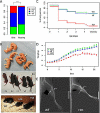Hyperactivation of Alk induces neonatal lethality in knock-in AlkF1178L mice
- PMID: 24811761
- PMCID: PMC4058038
- DOI: 10.18632/oncotarget.1882
Hyperactivation of Alk induces neonatal lethality in knock-in AlkF1178L mice
Abstract
The ALK (Anaplastic Lymphoma Kinase) gene encodes a tyrosine kinase receptor preferentially expressed in the central and peripheral nervous systems. A syndromic presentation associating congenital neuroblastoma with severe encephalopathy and an abnormal shape of the brainstem has been described in patients harbouring de novo germline F1174V and F1245V ALK mutations. Here, we investigated the phenotype of knock-in (KI) mice bearing the AlkF1178L mutation (F1174L in human). Although heterozygous KI mice did not reproduce the severe breathing and feeding difficulties observed in human patients, behavioral tests documented a reduced activity during dark phases and an increased anxiety of mutated mice. Matings of heterozygotes yielded the expected proportions of wild-type, heterozygotes and homozygotes at birth but a high neonatal lethality was noticed for homozygotes. We documented Alk expression in several motor nuclei of the brainstem involved in the control of sucking and swallowing. Evaluation of basic physiological functions 12 hours after birth revealed slightly more apneas but a dramatic reduced milk intake for homozygotes compared to control littermates. Overall, our data demonstrate that Alk activation above a critical threshold is not compatible with survival in mice, in agreement with the extremely severe phenotype of patients carrying aggressive de novo ALK germline mutations.
Conflict of interest statement
L. L.-D. and C. P.-E performed experiments at Institut Curie. E. B.-G., J.-L.D. and M. H. provided expertise for brainstem analysis,
Figures




Similar articles
-
The ALK receptor in sympathetic neuron development and neuroblastoma.Cell Tissue Res. 2018 May;372(2):325-337. doi: 10.1007/s00441-017-2784-8. Epub 2018 Jan 27. Cell Tissue Res. 2018. PMID: 29374774 Review.
-
Activated Alk triggers prolonged neurogenesis and Ret upregulation providing a therapeutic target in ALK-mutated neuroblastoma.Oncotarget. 2014 May 15;5(9):2688-702. doi: 10.18632/oncotarget.1883. Oncotarget. 2014. PMID: 24811913 Free PMC article.
-
Activating mutations in ALK provide a therapeutic target in neuroblastoma.Nature. 2008 Oct 16;455(7215):975-8. doi: 10.1038/nature07397. Nature. 2008. PMID: 18923525 Free PMC article.
-
Germline gain-of-function mutations of ALK disrupt central nervous system development.Hum Mutat. 2011 Mar;32(3):272-6. doi: 10.1002/humu.21442. Hum Mutat. 2011. PMID: 21972109
-
The role of anaplastic lymphoma kinase in pediatric cancers.Cancer Sci. 2017 Oct;108(10):1913-1920. doi: 10.1111/cas.13333. Epub 2017 Aug 24. Cancer Sci. 2017. PMID: 28756644 Free PMC article. Review.
Cited by
-
A Focus on Regulatory Networks Linking MicroRNAs, Transcription Factors and Target Genes in Neuroblastoma.Cancers (Basel). 2021 Nov 3;13(21):5528. doi: 10.3390/cancers13215528. Cancers (Basel). 2021. PMID: 34771690 Free PMC article. Review.
-
Multifocal Neuroblastoma and Central Hypoventilation in An Infant with Germline ALK F1174I Mutation.Diagnostics (Basel). 2022 Sep 19;12(9):2260. doi: 10.3390/diagnostics12092260. Diagnostics (Basel). 2022. PMID: 36140661 Free PMC article.
-
The ALK receptor in sympathetic neuron development and neuroblastoma.Cell Tissue Res. 2018 May;372(2):325-337. doi: 10.1007/s00441-017-2784-8. Epub 2018 Jan 27. Cell Tissue Res. 2018. PMID: 29374774 Review.
References
-
- Chiarle R, Voena C, Ambrogio C, Piva R, Inghirami G. The anaplastic lymphoma kinase in the pathogenesis of cancer. Nat Rev Cancer. 2008;8:11–23. - PubMed
-
- Hallberg B, Palmer RH. Mechanistic insight into ALK receptor tyrosine kinase in human cancer biology. Nat. Rev. Cancer. 2013;13:685–700. - PubMed
-
- Mano H. ALKoma: a cancer subtype with a shared target. Cancer Discov. 2012;2:495–502. - PubMed
-
- Janoueix-Lerosey I, Schleiermacher G, Delattre O. Molecular pathogenesis of peripheral neuroblastic tumors. Oncogene. 2010;29:1566–1579. - PubMed
Publication types
MeSH terms
Substances
LinkOut - more resources
Full Text Sources
Other Literature Sources
Medical
Molecular Biology Databases

